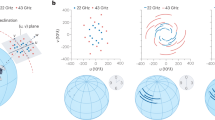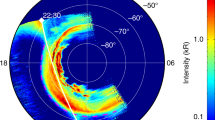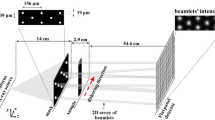Abstract
HIGH-ENERGY astrophysical sources can be difficult to image. Photons with energies above ∼5 keV are hard to focus, so experiments usually employ coded masks1–4 or moving collimators5–9 to modulate the flux received by the detectors; the resulting signals are then deconvolved to form the images. Here we demonstrate a new approach which makes use of the large-area, non-collimated detectors of the Burst and Transient Source Experiment on the Compton Gamma-Ray Observatory. As the spacecraft moves in its orbit, the Earth itself acts as a stable occulting disk. Changes in the measured signal during a single occultation correspond to the integrated intensity of sources positioned along the arc described by the Earth's edge (limb). The low-altitude, moderately inclined orbit of the spacecraft ensures that the angle at which the limb traverses a source region varies between occultations, and thus data from a series of occultations can be transformed into an image. This imaging process is conceptually and mathematically similar to those used in fan-beam aperture-synthesis radio-astronomy10 and medical computer-assisted tomography11, and holds great promise for all-sky imaging with relatively simple (and hence inexpensive) detectors.
This is a preview of subscription content, access via your institution
Access options
Subscribe to this journal
Receive 51 print issues and online access
$199.00 per year
only $3.90 per issue
Buy this article
- Purchase on Springer Link
- Instant access to full article PDF
Prices may be subject to local taxes which are calculated during checkout
Similar content being viewed by others
References
Fenimore, E. E. & Cannon, T. M. Appl. Opt. 17, 337–347 (1978).
Skinner, G. K. Nucl. Instrum. Meth. 221, 33–40 (1984).
Kohman, T. P. Rev. Scient. Instrum. 60(11), 3396–3409 (1989).
Skinner, G. K. Scient. Am. 259(2), 84–89 (August 1988).
Durouchoux, P., Hudson, H., Hurford, G., Hurley, K., Matteson, J. & Orsal, E. Astr. & Astrophys. 120, 150–155 (1983).
Mertz, L. N., Nakano, G. H. & Kilner, J. R. J. Opt. Soc. Am. A, 3, 2167–2170 (1986).
Caroli, E., Stephen, J. B., DiCocco, G., Natalucci, L. & Spizzichini, G. Space Sci. Rev. 45, 349–403 (1987).
Willmore, A. P. Mon. Not. R. Astr. Soc. 147, 387–403 (1970).
Cruise, A. M. Mon. Not. R. Astr. Soc. 170, 305–312 (1975).
Bracewell, R. N. Aust. J. Phys. 9, 198–217 (1956).
Gullberg, G. T. & Tsui, B. M. W. Information Processing in Medical Imaging (eds deGraaf, C. N. & Viergeren, M. A.) 181–189 (Plenum Press, New York, 1989).
Mertz, L. Transformations in Optics (Wiley, New York, 1965).
Mertz, L. in Proc. EUV, X-ray and Gamma Ray Instrumentation for Astronomy and Atomic Physics, SPIE 1159, 14–17 (1989).
Lei, F., Fraser-Mitchell, J. & Yearworth, M. Expl. Astr. 1, 285–303 (1991).
Fishman, G. J. et al. in Proc. Gamma—Ray Observatory Science Workshop (ed. Johnson, W. N.) 39–50 (NASA/GSFC, Greenbelt, MD, 1989).
Huesman, R. H. et al. Donner Algorithms for Reconstruction Tomography. LBL Publ. 214, 42–44 (University of California, Berkely, 1977).
Deans, S. R. The Radon Transform and Some of Its Applications (Wiley, New York, 1983).
Harmon, B. A. et al. IAU Circ. No. 5781 (1993).
Harmon, B. A. et al. in AIP Conf. Proc. 280, 314–318 Compton Gamma Ray Observatory (eds Friedlander, M., Gehrels, N. & Macomb, D.) (1993).
Skinner, G. K. et al. Nature 330, 544–547 (1987).
Claret, A., Goldwurm, A., Cordier, A. & Paul, J. Astrophys. J. (in the press).
Cook, W. R. et al. Astrophys. J. 372, L75–L81 (1991).
Sunyaev, R. et al. Astr. Astrophys. 247, L29–L32 (1991).
Sinner, G. Astr. Astrophys. Suppl. Ser. 97, 149–153 (1993).
Grindlay, J. E., Covault, C. E. & Manandhar, R. P. Astr. Astrophys. Suppl. Ser. 97, 155–158 (1993).
Bazzano, L. et al. Astr. Astrophys. Suppl. Ser. 97, 169–171 (1993).
Cordier, B. et al. Astr. Astrophys. Suppl. Ser. 97, 177–180 (1993).
Churazov, E. et al. Astr. Astrophys. Suppl. Ser. 97, 173–176 (1993).
Paciesas, W. S. et al. in AIP Conf. Proc. 280, 473–477 Compton Gamma Ray Observatory (eds Friedlander, M., Gehrels, N. & Macomb, D.) (1993).
Author information
Authors and Affiliations
Rights and permissions
About this article
Cite this article
Zhang, S., Fishman, G., Harmon, B. et al. Imaging high-energy astrophysical sources using Earth occultation. Nature 366, 245–247 (1993). https://doi.org/10.1038/366245a0
Received:
Accepted:
Issue Date:
DOI: https://doi.org/10.1038/366245a0
This article is cited by
-
On the Unified Scheme of γ-Ray Emitting Jetted Active Galactic Nuclei
Astrophysics (2023)
-
Correlations between X-ray outbursts and relativistic ejections in the X-ray transient GRO J1655 – 40
Nature (1995)
-
Hard X-ray all-sky imaging with BATSE/CGRO
Experimental Astronomy (1995)
-
Earth occultation or coded mask?
Nature (1994)
-
Earth occultation or coded mask?
Nature (1994)
Comments
By submitting a comment you agree to abide by our Terms and Community Guidelines. If you find something abusive or that does not comply with our terms or guidelines please flag it as inappropriate.



